In this era of video content creation, you might think that more or less every laptop should be equipped for video editing. But sadly, that’s not the reality.
While you can trim and merge clips in virtually any laptop, what a regular laptop lacks is a high-resolution screen, potent processor power, sufficient RAM, and the power of a magnificent graphics card.
With the best laptop, you don’t have to restlessly wait for the renders to finish or pick your hair over an unresponsive and slow processor. Not to mention, it offers ample storage space to store high-resolution video files.
So, whether you are an entry-level video editor or have been in the profession for some time, you will need a device that lets you do the memory-intensive job with ease.
However, the primary concern is, such high-definition laptops don’t come cheap. And they tend to be quite heavy as well, which would, again, limit you if you need a mobile workstation.
Nevertheless, considering every aspect, we managed to round up some of the impressive options on the market over a range of budgets. Read on, and be aware of all the details to choose the best video editing laptop.
Table of Contents
Best Premium Laptops for Video Editing
Read these reviews right away, take notes if needed, and get your hands on the one that fits your priority.
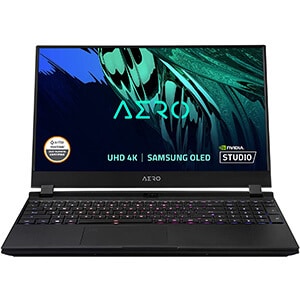
1. GIGABYTE AERO 15
- Display: 15.6” 4k
- CPU: Intel Core i7-11800H
- GPU: NVIDIA GeForce RTX 3070
- RAM: 16 GB
- Storage: 1tB SSD
If you’re familiar with PC accessories, you definitely know the brand name GIGABYTE. While producing motherboards is the brand’s primary specialty, they work on graphics cards with AMD and Nvidia.
This very company is producing high-end laptops. Exciting, isn’t it? So, what do we need in a laptop for video editing?
When it comes to video editing, color grading is probably the most important thing. For better color correction, you surely need a better screen.
GIGABYTE AERO 15 offers an OLED display that will allow you to see the right colors. Also, in terms of durability, OLED is the flagbearer of laptop displays. The 15.6″ thin OLED display will let you enjoy your video editing in 4K.
The performance is necessary when you’re editing and rendering 4k videos. The device comes with 16GB RAM and 1TB SSD.
If you want some extra memory to work with, there’s good news for you. It will also let you expand your RAM up to 64GB. So, good luck with overclocking.
On top of that, the device comes with the Nvidia GeForce RTX 3070 GDDR6 GPU to improve your rendering time. In addition, the 11th gen Intel Core i7 further ensures smoother and faster running high-definition video editing software.
The body of AERO 15 is designed for gamers. The RGB keyboard and raised display features are incredible.
The power button is placed on the touchpad, which is convenient for users. The whole package is lighter than other high-end laptops on the market as well.
Every laptop has its shortcomings; this one is no different. The average speaker and placement of the webcam won’t satisfy most of the users.
Pros
- 4k AMOLED Display allows for accurate color grading
- AI rendering with Nvidia DLSS will shorten the time for rendering
- Lightweight for a high-end laptop, easy to carry around, and do editing anywhere
- Windforce cooling system keeps the laptop stable at peak performance
- Quality job in body finishing will attract anyone.
Cons
- The average audio output might get in the way with audio editing
- Webcam is at the bottom of the display, which is annoying during video calls
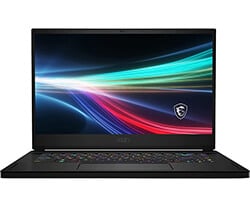
2. MSI Creator 15
- Display: 15.6” 4k
- CPU: Intel Core i7-11800H
- GPU: NVIDIA GeForce RTX 3060
- RAM: 16 GB
- Storage: 512GB SSD
Usually, most people tend to believe that the finest gaming laptops would be the best video editing laptop as well.
While this isn’t entirely false, focusing just on gaming capabilities might cause you to miss out on features that would improve your editing and design experience.
So, allow us to introduce you to the MSI Creator 15, designed with editors, designers, and creators in mind.
The device comes with a 15.6 inches OLED display that offers gorgeous color contrast, easing the process of video color grading by portraying the true colors.
The display supports a maximum resolution of 3840×2160. So, working with high-definition video files shouldn’t be a problem.
Although primarily designed for creators, the device is capable of providing an enhanced gaming experience.
Equipped with the 11th gen Intel Core i7-11800H processor, which offers 2.4 GHz to max 4.6 GHz processor speed, the device allows you to tackle every demanding task with ease.
The device didn’t compromise on the GPU either. The NVIDIA GeForce RTX 3060 boosts the Creator 15’s muscular strength even further. It also comes with the optimum 16 GB memory and 512 SSD.
On the flip side, at 5.39 pounds, the Creator 15 is one of the heaviest laptops available. So, portability is not one of its strongest suits.
Nonetheless, the laptop is an excellent choice for students and professionals who want to go on a creative path with video content creation. Not to mention, the battery life is impressive as well.
Pros
- Designed for creators, editors with a gorgeous 15.6-inch OLED screen
- The powerful Core i7-11800H processor delivers high speed and performance
- It comes with an impressive GPU option for a smoother gaming experience
- 3840×2160 offers excellent color accuracy and contrast
- Battery backup is decent
Cons
- Portability is limited by the laptop’s heavyweight
- The device is expensive for what’s it offering
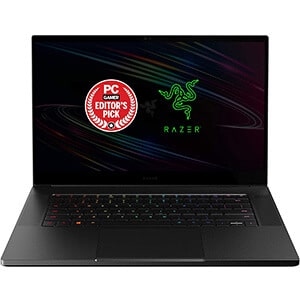
3. Razer Blade 15
- Display: 15.6” 1080p
- CPU: Intel Core i7-10875H
- GPU: NVIDIA GeForce RTX 2080 Super Max-Q
- RAM: 16 GB
- Storage: 1TB SSD
The name Razer Blade is quite popular among gamers. While being a well-known brand in the gaming world, it also faces criticism for its overpriced products.
However, you are sure to enjoy an uncompromised gaming experience, and the Razer Blade 15 is no exception.
The first thing that attracts people is the body of the Razer Blade 15. The thin metal finishing makes it durable even with rough use.
The whole package only weighs 4lbs which is extremely low for a gaming laptop. In addition, the Razer Blade logo on the back showcases a premium vibe and is worth every penny.
A thin body doesn’t always mean that you’ll get fewer ports. The device comes with three USB 3.1 ports and a reversible USB type-c port.
So, if you’re not comfortable with a touchpad, you can use a mouse. In addition, the full HD display with a 300hz refresh rate will smooth your ventures.
The inside holds the precious 10th generation i7-10875H processor from Intel and 16 GB RAM.
The special edition of Nvidia GeForce RTX 2080 with Max-Q design will keep the rendering going far smoother and faster than other RTX 20 series graphics cards. So, you can do both video editing and gaming in smooth 60fps.
Another great addition to black marvel is the battery backup. The continuous video screening test by PCMark shows the result of more than 5 straight hours of backup.
The cooling system got excellent feedback from the users, which is a great help when you’re utilizing the GPU and CPU to their full capacity.
All these features come in great appearance with the RGB keyboard in the front with a very user-friendly touchpad.
The biggest downside, however, is the price. Also, the Blade 15 could’ve better regulated the heat generated by all the high-end components.
Pros
- The best GPU option in RTX 20 series will provide a smooth rendering
- Slim and easy to carry around, it weighs less than other high-end laptops
- Durable metal finishing can absorb enough careless falling
- Well finished body with attractive logo and simple color
- Normal but notable battery backup can give you enough time to finish your running project
Cons
- The body gets heated during high usage of CPU and GPU
- Overpriced, you definitely can find the same specs at a lower price
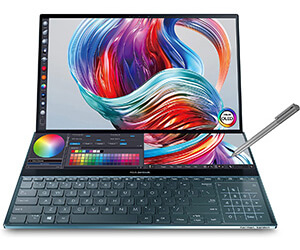
4. ASUS ZenBook Pro Duo
- Display: 15.6” 4k
- CPU: Intel Core i7-10750H
- GPU: NVIDIA GeForce RTX 2060
- RAM: 16 GB
- Storage: 1TB SSD
If you want to build a luxury workstation and don’t mind spending a lot of money, the ASUS ZenBook Pro Duo might be the best laptop for 4k video editing money can buy.
The device’s main selling point is its one-of-a-kind dual screen, a wish-fulfillment for most immersive content creators and editors.
It includes a secondary screen of 14 inches 3840×1110 display, namely Screenpad Plus, along with the main 15.6 inches OLED 3840×2560 4K UHD display.
And both the displays are 4K, portraying remarkable quality images with excellent contrast, vivid, and accurate colors. And without having to connect a second monitor, you can divide your windows and work on both screens simultaneously.
So, with the addition of the Screenpad Plus, the premium laptop might be everything every designer and multitasker ever wanted.
That being said, the incorporation of the second screen induces some drawbacks. For instance, the keyboard is pushed to the edge, while the original touchpad is cornered to one side.
Also, the addition makes the laptop impractically heavyweight, expensive, and power-consuming.
Nevertheless, the ZenBook Pro Duo, weighing 5.51 pounds, is preferred as a fixed workstation, and you can get used to the keyboard and touchpad placement in no time.
A powerful processor configuration with 10th gen Core i7-10750 having a base CPU speed of 5.0 GHz further justifies the price.
The discrete RTX 2060 GPU adds to the workhorse muscle, allowing you to perform any and every demanding task at a lightning-fast speed.
It offers 16 GB RAM and 1 TB SSD memory-wise, which should be ample space to store all your essential footage.
Although the Pro Duo has a Thunderbolt 3 USB type C and 2 USB type A, there are no Ethernet ports and SD card slots.
Pros
- It comes with two high-resolution screens, a 15.6-inch main display, accompanied by 14-inch Screenpad Plus
- Multitasking is made easy due to the dual-screen
- The powerful Core i7-10750H processor ensures a smoother and faster running laptop
- 1 TB SSD makes it suitable for 4k video editing and storage
- Discrete RTX 2060 GPU enables video gaming with ease
Cons
- The device is cumbersome and impractical to carry along
- One of the priciest laptops on the market
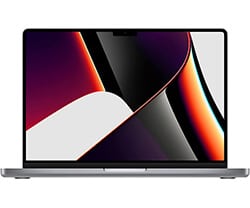
5. Apple MacBook Pro M1 Pro
- Display: 14.2” Retina Display
- CPU: 8‑core CPU
- GPU: 14‑core GPU
- RAM: 16 GB
- Storage: 512GB SSD
Not everyone is fond of Windows. Many professional video editors prefer software like Final Cut Pro, which Mac OS only supports. Here are our thoughts on what Apple has stored for you.
Apple MacBook Pro comes with a tremendous M1 Pro chip which tops almost every intel i7 processor in the benchmark.
So, the processor is undoubtedly far more superior, faster, and high performing. They also included an 14-core GPU to enhance your work experience.
The new Apple MacBook Pro with Apple M1 Pro chip comes with 16GB of unified memory, which can be configurable up to 64GB. In addition, the superfast SSD is introduced in hard drives, so expect minimum loading time during edits.
You also get to enjoy the lightning-fast file transfer at 40 Gbps with the USB 4 port.
Something that truly takes all the attention is the Pro M1’s battery. The device introduces the longest-running battery in Apple history. The battery itself will get you through around 20hrs after being fully charged.
In addition, the Apple device comes with a 14.2-inch Retina display. The LED-backlit display offers a 3024×1964 resolution with True Tone technology, improving its readability in every setting.
While our No. 1 product is also struggling with the monitor brightness, Apple offers 500 nits brightness. These features will ease your struggle in color grading.
The MacBook Pro comes in two different storage sizes to start with, 512GB and 1TB. Well, everyone knows we need a bigger storage capacity for scratch disks.
Well, though they lack capacity in built-in laptops, you have an option to buy the 2TB version or even 8TB.
If you’re considering a MacBook for the first time, here’s some caution you need to know. Shifting from Windows to Mac is a big step because MacBooks aren’t built for gaming.
While it may assist you in video editing and other office work, professionals do not recommend using MacBook for gaming. There are also some limitations software-wise.
Pros
- Stylish, slim, and easy to carry around for portable use
- Battery life will let you keep your work going up to 20 hours
- Making file transfer smooth with a USB 4 port with speed up to 40GB per second
- Exclusively supports Final Cut Pro and other video editing software like Premiere Pro and Davinci
- True Tone technology for accurate color will come in handy for color grading
Cons
- High-end laptop but not suitable for gaming purpose
- The Macbook Pro comes at an extremely high price
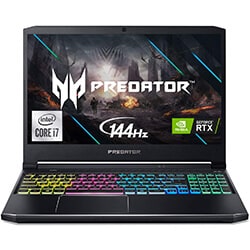
6. Acer Predator Helios 300
- Display: 15.6” 1080p
- CPU: Intel Core i7-10750H
- GPU: NVIDIA GeForce RTX 3060
- RAM: 16 GB
- Storage: 512GB SSD
The Acer Predator Helios 300 is an example that the best laptop for video editing doesn’t have to cost a fortune.
Equipped with a 10th generation Intel Core i7-10750H processor, 16GB RAM, and 512GB SSD, the Predator is tough to beat at this price range.
The mid-range gaming laptop comes with the NIVIDA GeForce RTX 3060, which makes the rigorous video editing tasks a breeze. Not to mention, the gaming performance is quite impressive as well.
It also features one-touch overclocking with the turbo button. So, wherever you are in the middle of more memory and power-intensive job, you can switch to turbo mode. But we should give a heads up that the fan’s noise is noticeably loud.
The 15.6-inch full HD display with backlit LED is significantly bright and offers a refresh rate of 144 Hz. So, you are sure to enjoy an impressive frame rate in every setting, with a maximum of three-digit rates in not so resource-intensive games.
However, the device is a bit heavy, weighs 4.85lbs, making it somewhat difficult to carry all the time.
The 4-zone RGB keyboard with Predator typeface again enhances your editing and gaming experience.
Moreover, it also comes with a wide range of connectivity features, including HDMI 2,0 and DisplayPort 1.4, allowing you to connect, play, and work on three screens altogether.
And you can connect your other peripherals using the USB 3.2 Gen 1, Gen 2, and Type C ports.
Apart from all these features, the metal body, elegant design with a cool Predator logo at the back set a professional vibe to your workstation. The battery life is decent too. The fully charged Li-ion battery can last up to 6 hours.
All in all, the device is a perfect combination of features, allowing you to do all the high-definition works while not emptying your wallet.
Pros
- A medium-range gaming laptop at an affordable price range
- Built-in overclocking with a turbo button
- It comes with an HDMI 2.0 and DisplayPort 1.4 to connect two screens
- Enhanced gaming and editing experience with customized Predator typeface keyboard
- A wide range of connectivity to connect all your peripherals
Cons
- Somewhat heavy and difficult to carry
- It doesn’t include any SD card reader
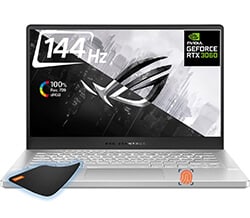
7. ASUS ROG Zephyrus G14
- Display: 14.0” 1080p
- CPU: AMD Ryzen 7 5800HS
- GPU: NVIDIA GeForce RTX 3060
- RAM: 24 GB
- Storage: 1TB SSD
Moving on, we have another excellent laptop that offers high portability and significantly longer battery life always to have your workstation on the go.
Weighing only 3.64 lbs. and allowing you to run continuously for 11 hours, the ASUS ROG Zephyrus G14, the 14-inch seamless laptop, is the ultimate dream device for many editors and gamers around.
The tiny beast comes with many powerhouse features, including a massive 24GB RAM and the newest AMD Ryzen 7 processor that offers a CPU speed of 2.8GHz, making it suitable for 3D modeling, video editing, graphics design, etc.
The GPU, Nvidia GeForce RTX 3060, and a dedicated VRAM of 6GB allow you to handle the most power-hoarding complex renders efficiently.
It has a 1TB SSD as well. So, stockpiling on a large number of 4k footage shouldn’t be a problem for professional and amateur editors alike.
The thermal regulation is again impressive. The device never gets too hot, even with all these powerful components fitted into a compact 12.8 x 8.7 x 0.7 inches metal body.
And apart from being the thinnest and lightest laptop in this range, the device offers a full HD display with a refresh rate of 144Hz. The robust sound provided by the two 2.5W speakers is hard to beat as well.
While the slim configuration is amongst the top-selling points of the ASUS G14, the downside is, it couldn’t accommodate a webcam. However, that doesn’t make a hardcore gamer or editor hesitant to go with this tiny power-crammed device.
The keyboard’s backlit is again not very well-designed. But you are getting a ton of outstanding qualities without paying an insane amount of money. So, it wouldn’t be wrong to call this the best laptop for video editing and gaming for anyone on a budget.
Pros
- The ultra-slim 14-inch gaming laptop offers high portability
- One of the longest battery life lasts up to 11 hours
- AMD Ryzen 7 processor is backed by RTX 3060, allowing you to run any power-intensive software with ease
- The 2.5W speakers produce impressive sound
- It never gets too hot, even when running at its highest
Cons
- It doesn’t include a webcam for live video gaming or conferencing
- The lousy keyboard backlit doesn’t help typing in the dark
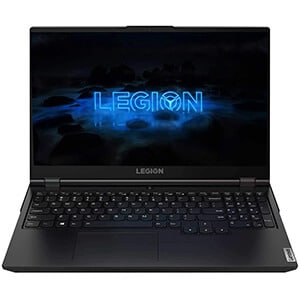
8. Lenovo Legion 5
- Display: 15.6” 1080p
- CPU: AMD Ryzen 7 4800H
- GPU: NVIDIA GeForce RTX 2060
- RAM: 16 GB
- Storage: 512GB SSD
The Lenovo Legion includes a line of laptops for gamers and content creators that come in a variety of pricing points. The brand is continuously upgrading the series with the latest processors and GPU while being conservative in terms of cost.
This model of Lenovo Legion 5 comes with AMD Ryzen 7 4800H 8C/16T, which is far more efficient than the closest intel competitor Intel Core i7-10750H for multi-core applications.
With a processor speed of 2.9GHz, which can be maximized to 4.2GHz, the device is more than capable of handling high-definition video works. Besides, backed by the RTX 2060 GPU, the gaming performance is entirely satisfactory as well.
Furthermore, what appeals to most users is the minimal heating issue even when the GPU and CPU are working at their fullest. The quiet running fan further eliminates the need of using a headphone while doing immersive focus works.
As per the memory, it comes with 16 GB DDR4 RAM and 512 SSD, which doesn’t seem like much, but you can upgrade it to 32 GB and 2 TB. And yes, the customizable ease of the laptop is another thing that attracts gamers and designers alike.
The 15.6 inches screen is equipped with FHD display technology that supports 1080p HD resolution and provides a refresh rate of 144Hz. And with the assistance of the powerful CPU and GPU, you are sure to enjoy a higher frame rate as well.
We also love the multiple connectivities of the device. Thanks to the 4 USB ports and the HDMI 2.0. The only downside we assume is the 5-hour average battery life on low load and 3-hour on high. Meaning, you’ll have to keep it plugged in most of the time.
However, that doesn’t seem to bother most users, as the 2.4 kg heavy device is better to use as a fixed workstation rather than always carrying it with you.
Overall, the robust gadget with a minimalistic design is a solid pick for anybody seeking a low-cost, high-definition alternative.
Pros
- It comes with AMD Ryzen 7 4800H, which is significantly faster than its intel competitor
- The RTX 2060 GPU enhances the gaming and editing experience
- Easily upgradeable and customizable device
- Sturdy configuration and a simple appearance
- An affordable mid-range gaming laptop
Cons
- Significantly heavy, which limits its portability
- Battery life is not very impressive and requires you to have the charger around
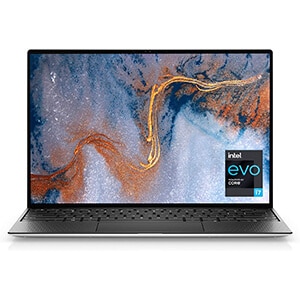
9. Dell XPS 13 9310
- Display: 13.4” 1080p
- CPU: Intel Core i7-1185G7
- GPU: Intel Iris Xe Graphics
- RAM: 16 GB
- Storage: 512GB SSD
Dell continues to push the benchmark of ultra-thin, high-performance laptops with its XPS series and the Dell XPS 13 9310 is another flawless addition to this specific line of products.
The first thing we would like to address about the mini yet muscular laptop is its gorgeous outlook. Measuring only 7.82×11.64×0.58 inches, the elegant frost-white device with beveled edges is an absolute stunner.
And weighing only 2.8 pounds, it’s by far the lightest laptop on this list.
Notorious battery life of 13 hours is another thing with which the XPS 13 outperforms other windows laptops. However, the battery performance notably depends on brightness level.
Performance and power-wise, we don’t hesitate to call this little beast the best windows laptop for video editing.
Armed with the 11th gen Intel Core i7-1185G7 that offers a base processor speed of 3.0 GHz and a maximum turbo frequency of 4.8GHz, the gadget is suitable for an intensive workload.
In addition, the Intel Iris Xe Graphics is a substantial improvement over the previous Intel Iris Plus. So, even without a discrete Graphics card, the device is more than capable of providing a smoother gaming performance.
However, immersive gaming is not recommended as the device can get quite hot for accommodating such heat-generating components within a compact space.
Now, about the display, the 13.4-inch FHD display with InfinityEdge Touch is both anti-smudge and anti-reflective. Moreover, the color correction of the full HD display is again gorgeous. So, the editing on this stunner is indeed a breeze.
However, the ultra-slim design has some downsides, including a lower-than-average quality webcam and only two USB ports. You will get an SD card reader and a USB type C to type A adapter, though.
Pros
- Stunning ultra-slim design with a beautiful color
- Very convenient to carry as being one of the lightest Windows laptops
- 11th generation Intel Core i7-1185G7 processor is designed for high-definition tasks
- It can last up to 13 hours on lower brightness levels
- Larger screen ratio and high color accuracy make video editing a breeze
Cons
- It couldn’t accommodate a well-engineered cooling system, so the device gets significantly hot
- You have to compromise on the number of USB ports
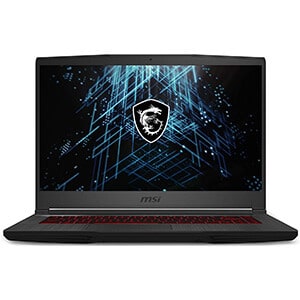
10. MSI GF65 Thin
- Display: 15.6” 1080p
- CPU: Intel Core i7-10750H
- GPU: NVIDIA GeForce RTX 3060
- RAM: 32 GB
- Storage: 1TB SSD
MSI is a leading manufacturer in the gaming industry. This time they came up with a high-end budget laptop for heavy-duty work. The GF65 series continues to add astonishing yet affordable laptops for budget gamers.
The inside of GF65 is decorated with Intel Core i7 10th generation processor. The six-core processor can boast a speed up to 5Ghz, meaningless rendering time, and smooth transitions.
You’ll definitely need a quality GPU with a CPU like this, and the device doesn’t fall back on that. So, it comes with NVIDIA GeForce RTX 3060, which has a benchmark of 87.6%. It’s easy to get some smooth 60fps playback.
In terms of memory and storage, MSI offers four different options for you. The 16GB RAM with 1TB of NVMe SSD is their lowest offering.
If you want larger disk storage and memory capacity, they have up to 64GB of RAM and 2TB of high-speed SSD.
We recommend you go with the 32GB RAM, which is the closest to perfect choice for video editing.
The FHD display with a refresh rate of 144Hz will keep your work at the edge. There’s no place for an old, slow HDD for storage in a laptop like this. MSI uses a Samsung SSD of 1024 GB capacity.
With all these mighty elements inside, it weighs only 4.1 pounds. Also, the price is reasonable compared to other laptops with the same configuration.
Pros
- Premium quality laptop at a lower price for your video editing ventures
- No heating problems or performance drops were found during working at peak settings
- It gives four different options for memory and storage capacity
- You can overclock with the slots available and spice things up according to your preference
- The powerful RTX 3060 GPU adds to the performance power
Cons
- The fans make quite a noise after the Cooler Boost is activated
- Low battery backup and slow recharge rate
What to Look For in a Video Editing Laptop
Sadly, while shopping for a dedicated video editing laptop, you don’t have as many options as gamers. And the reason is that you can hardly find any manufacturer that designs laptops specifically with video creation in mind.
The end result is you would have to pick one among the available categories to accommodate all your needs. So, below are some crucial things to consider while shopping for a video editing laptop.
CPU
The CPU or processor is the key to making video editing software run more smoothly. A multi-core processor with a minimum of 4 cores and 8 threads is recommended for video editing of any kind.
And the higher the core numbers, the better, as the PC’s performance increases with the core count.
Pay attention to the clock speed or base processor speed as well. The CPU should have a frequency of 1.5GHz or higher.
Both Intel and AMD offer a series of impressive CPUs that are capable of high performance and speed. You can opt for the newest generation of Intel i5, i7, or i9 laptops. AMD’s 4000 and 5000 series CPUs are pretty similar too.
However, the professional recommendation is to check with the manufacturer’s directory or product pages to learn about the product’s cores, threads, and clock rate.
Graphics Acceleration: Dedicated GPU or Not?
This may come as a surprise, but dedicated graphics is not always necessary for video editing.
Undoubtedly, a graphics card compliments the CPU and gives the editing software a power advantage; a high-end GPU will significantly outstretch your budget while being overkill for the purpose.
There are, however, some exceptions. Software like Davinci Resolve and Final Cut Pro are mostly powered through the GPU and require a robust graphics card.
So, unless you are into the filming and editing industry, we would say a mid-range NIVIDA or AMD GPU is adequate for all your editing needs. And if you don’t have the budget, you can rule out the GPU option and opt for a powerful processor instead.
RAM
RAM, the short term for Random Access Memory, is what keeps your applications running. For a clearer view, RAM is more like HDD or SSD.
The major difference between these is HDD or SSD stores your files and applications, and RAM is the memory to run them.
So, the amount of RAM you need depends on how many programs you plan on running at once. The loading time of the applications and generating previews are the works of RAM.
It is preferable to use a minimum of 8GB RAM for video editing purposes. But when using the 8GB RAM, you might not want to run extra applications in the background.
You can edit only 1080p videos. So, if you want to edit 4k videos and some background programs at a time, a minimum of 16 GB RAM is recommended.
For longer and 8k videos and multiple projects at a time, you can get a 32GB or 64GB one.
Storage
No one likes a loading screen or slow transfer rate of files. When it comes to storage, you need to check some expectations first. That includes asking yourself how much storage capacity you will need in the future.
If you’re not using any cloud storage, we recommend you get the largest one under your budget. The next thing to consider is the transfer speed. The speed is the major difference between the two available storage types, HDD and SSD.
For video editing, we don’t recommend using HDD. You can opt for an HDD for budget arrangement.
However, the best option for higher performance and speedy transfer is an M.2 PCIe NVMe SSD. It is a bit pricy, though. So, the optimum solution would be to get an additional HDD with one main SSD for your system.
Display
The display is another essential parameter for choosing the optimized option. And apart from choosing the right screen size, you have to check for the resolution, refresh rate, contrast, and brightness.
Most modern laptop displays support a resolution not lower than 1920x1080p full HD. So, unless you are working with 4K footages, the size should not be your primary concern. Now, powerful configuration laptops are usually 15 inches or larger.
If you feel like that would be hard to carry, opt for 13 or 14 inches, one that doesn’t compromise on the power features. Also, for working with 4K files, a resolution of 3840x2160p is the way to go.
Next comes the color capabilities of the display. OLED screens are preferred by professionals for their excellent color contrast and accuracy.
Features like RGB color-gamut, decent brightness, and automatic calibration are also worth considering for professional color precision jobs. Additionally, a minimum refresh rate of 60Hz is also recommended.
Size and Weight
The size and weight account for the laptop’s portability and are a crucial consideration before buying. A laptop that houses a powerful processor and GPU tends to be larger and heavier.
Now, a larger laptop means you get a bigger screen as well. However, heavier devices might be impractical depending on your preference for a mobile or fixed workstation.
Nevertheless, if mobility is one of your top priorities, you can find some high-tech ultra-thin laptops with great specifications. Be aware of the trade-offs for the size, though.
Battery life
Longer battery life is a precious feature that every designer wants to have in their laptop. However, the task of editing video is battery draining, especially if you are working on 4K footages or running applications that are powered through the GPU.
Hence, most high-definition laptops don’t hold power for long. You can, however, find devices with an impressive battery life of over 8 hours. Such devices will allow you to work for hours without having to sit close to a power outlet.
But make sure the device doesn’t compromise on the CPU power for providing extended battery backup.
Audio
While audio is not among the most important features to consider, you will undoubtedly benefit from a quality audio output, especially if your editing piece requires music mixes.
A lousy audio quality is neither appreciable nor helpful for accurate hearing. Nevertheless, you can invest in a quality headset or external speaker for audio accuracy.
Connectivity
A lack of ports can be frustrating, especially when you are not used to only one or two ports. Even the absence of the SD card reader might be disruptive.
So, the number of ports adds to the convenience and ease of use. Not to mention, with an HDMI and DisplayPort, you can add 2 external screens simultaneously.
Usually, you don’t have to worry about the connectivity with larger laptops as they come with multiple ports.
However, if you are opting for a thinner laptop for easily carrying it around, make sure it has 2 USB 3.0 or 3.1 ports and 1 Thunderbolt 3 at the least.
Frequently Asked Questions
1. What laptop specs are ideal for video editing?
The specs you need to check for video editing are the processor, RAM, display, storage, and GPU.
The i7 latest generation processor for windows and MI1 chip for Apple are preferable for rigorous video editing tasks. You can go for AMD processors, too, if you’re looking for something under the budget.
A minimum of 8GB RAM is necessary for getting things running. It is ideal to use 16GB to 32GB for heavy-duty functions.
For GPU, consider at least a 4GB GPU from Nvidia or AMD. Lastly, an SSD is preferable for storage. You can use HDD, too, which is a bit slower.
2. Mac or Windows laptop for video editing?
Well, this choice depends on a lot of factors, including your personal preference and professional requirement. While editing on Windows allows you to have a wide range of choices for the processor, Mac is more of a classic choice for pro editors.
And most professional editors tend to prefer the best apple laptop for video editing over any windows device.
Also, before asking this question, you must be sure which platform you’ll use for editing. There are a lot of choices available in the market.
The most popular software choice is the Adobe Premiere Pro, which runs on both Mac and Windows. But the professional’s choice is Final Cut Pro. But, it doesn’t have a windows version to date.
3. Can you use gaming laptops for video editing?
You most definitely can. Gaming PCs are designed to perform at full capacity and retain maximum frame per second (fps), which is almost what a video editor needs during their work. Also, high-end CPUs and GPUs decrease the rendering time significantly.
4. Can you edit 4k videos on a 1080p laptop?
Yes, you can. If your software and laptop configuration can handle a 4k video, you can edit 4k videos. The 1080p dictates the output you will see on your laptop’s display.
You can edit 4k videos with the correct encoding while exporting the file. But with a 4k display, you get the chance to watch real-time previews, which is super cool.
5. Is the MacBook Air M1 good for video editing?
Due to its outstanding performance, long battery life, and surprisingly low price for an Apple product, the MacBook Air M1 isn’t just one of the best laptops for video editing; it’s one of the best laptops you can buy overall.
Check out this post to learn more about the MacBook Air M1 for video editing.
6. Is 8 GB RAM enough for video editing?
The main job of RAM in video editing is caching the preview files. RAM decides the resolution you’ll be allowed to edit the video. So, is 8GB RAM preferable? 8GB RAM is actually the minimum requirement for video editing.
Yes, you can do video editing even in 4GB RAM, but that wouldn’t be smooth enough.
So, for 1080p quality video editing, 8GB RAM would work, but you can’t run other applications in the background. So, it is ideal to use 16GB, allowing you to work with videos of up to 4k quality.
Conclusion
Well, it is a wrap-up on the best laptop for video editing. Throughout the article, we tried to give you an insight into the detail which contribute to making a laptop ideal for the memory and power immersive function.
The top 10 laptops listed above are all high definition and suitable for the most demanding editing jobs. So, choosing one comes down to how you intend to build your workstation and whether or not you want a gaming laptop.
Nevertheless, the list contains a wide spectrum of products, from ultra-thin and light ones to power cramming hefty devices. So go ahead, pick one, and enjoy the beauty of video creation.
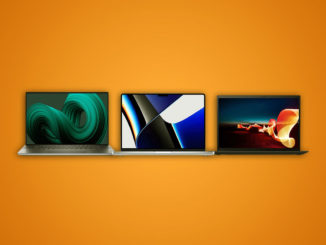
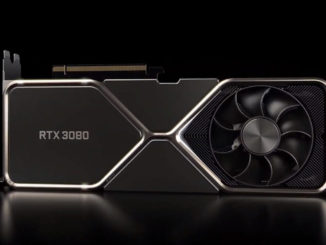
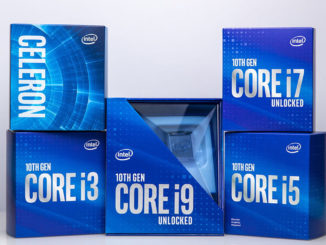

Be the first to comment